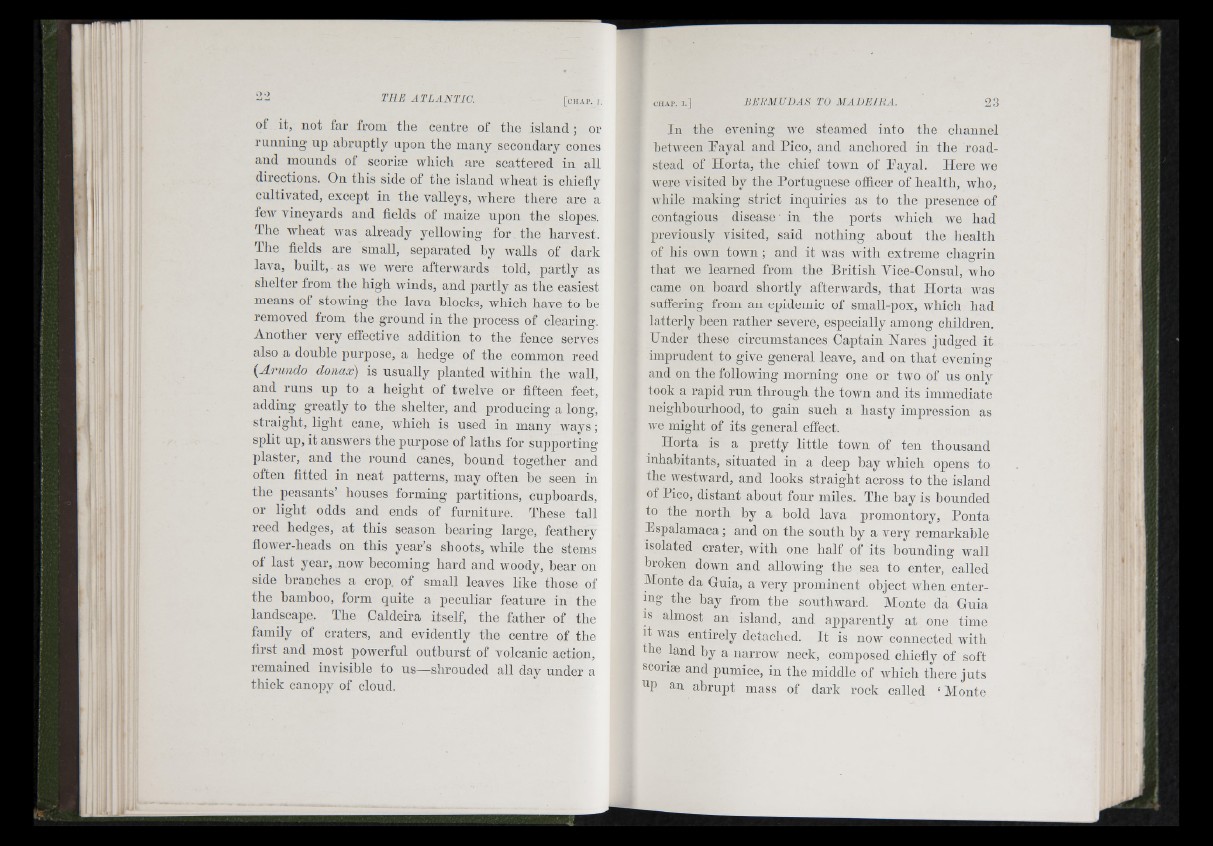
oi it, not far from the centre of the island ; or
running up abruptly upon the many secondary cones
and mounds of scoriæ which are scattered in all
directions. On this side of the island wheat is cliiefly
cultivated, except in the valleys, where there are a
tew vineyards and fields of maize upon the slopes.
The wheat was already yellowing for the harvest.
Tlie fields are small, separated by walls of dark
lava, built, as we were afterwards told, partly as
shelter from the high ndnds, and partly as the easiest
means of stowing the lava blocks, which have to be
remoAæd from the ground in the process of clearing.
Another very effective addition to the fence serves
also a double purpose, a hedge of the common reed
{Arunclo doncix) is usually planted within the Avail,
and runs up to a height of twelve or fifteen feet,
adding greatly to the shelter, and producing a long,
straight, light cane, Avhich is used in many Avays ;
split np, it answers the purpose of laths for supporting
plaster, and the round canes, hound together and
often fitted in neat patterns, may often be seen in
the peasants’ houses forming partitions, cupboards,
or light odds and ends of furniture. These tall
reed hedges, a t this season hearing large, feathery
floAver-heads on this year’s shoots, while the stems
of last year, now becoming hard and woody, bear on
side branches a crop of small leaves like those of
the bamboo, form quite a peculiar feature in the
landscape. The Oaldeira itself, the father of the
family of craters, and evidently the centre of the
first and most poAverfnl outburst of volcanic action,
remained iuA’isible to us—shrouded all day under a
thick canojAy of cloud.
In the evening Ave steamed into the channel
hetAA-een Fayal and Pico, and anchored in the roadstead
of Horta, the chief toAvn of Fayal. Here we
Avere visited by the Portuguese officer of health, who,
Avhile making strict inquiries as to the presence of
contagious disease in the ports Avliich Ave had
previously visited, said nothing about the health
of his own toAvn ; and it was Avith extreme chagrin
that Ave learned from the British Vice-Consul, avIio
came on hoard shortly afteinvards, th a t Ho rta Avas
suffering from an epidemic of small-pox, which had
latterly been rath e r severe, especially among children.
Under these circumstances Captain Nares judged it
imprudent to give general leave, and on th a t evening
and on the following morning one or two of us only
took a rapid ru n through the toAvn and its immediate
neighbourhood, to gain such a hasty impression as
Ave might of its general effect.
Horta is a pretty little town of ten thousand
inhabitants, situated in a deep bay Avhich opens to
the westAvard, and looks straight across to the island
of I ico, distant about four miles. The bay is bounded
to the north by a bold lava promontory, Ponta
Espalamaca; and on the south by a very remarkable
isolated crater, with one half of its hounding Avail
broken doAvn and alloAving the sea to enter, called
Monte da Guia, a very prominent object Avhen entering
the hay from the sontliAvard. Monte da Guia
IS almost an island, and apparently at one time
itAias entirely detached. It is now connected Avith
the land hy a narroAv neck, composed chiefly of soft
scoriae and pumice, in the middle of which there ju ts
up an abrupt mass of dark rock called ‘Monte